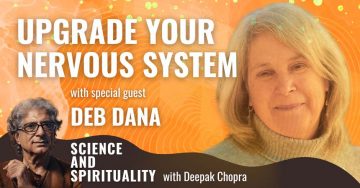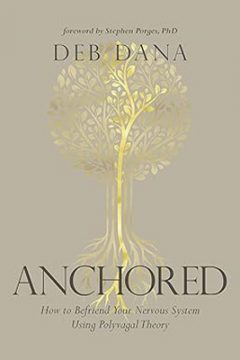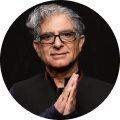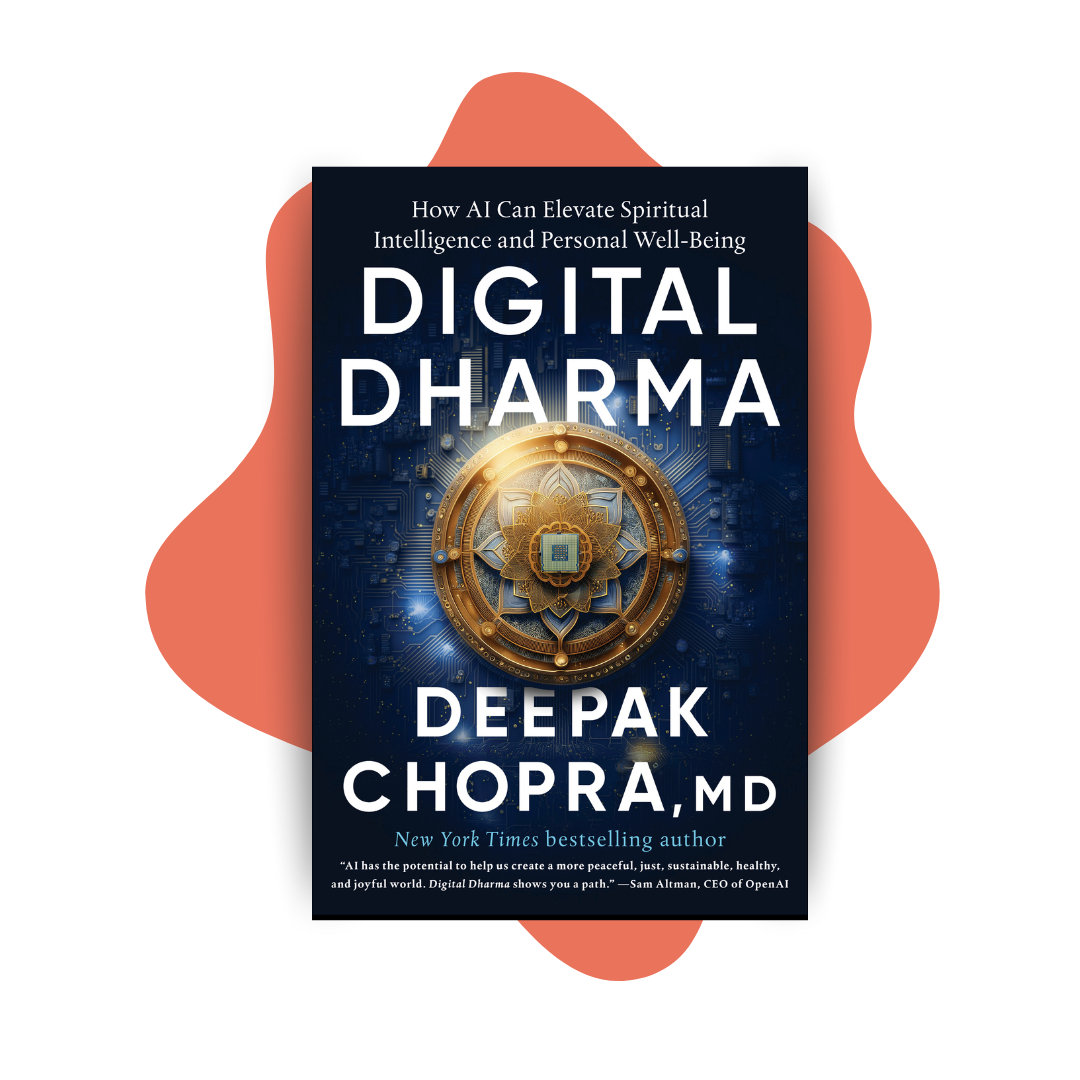Home › Podcasts › Science and Spirituality with Deepak Chopra › Upgrade Your Nervous System With Deb Dana
Upgrade Your Nervous System With Deb Dana.

Why should you upgrade your nervous system? Today, let’s explore the concept of Polyvagal Theory and how to use it to understand and regulate our nervous response. Join Deepak Chopra and Deb Dana for a deep dive into the vagus nerve, the key to unlocking wellbeing, connection, and calm. Deb, author of Anchored: How to Befriend Your Nervous System Using Polyvagal Theory, gives us an in-depth understanding of the vagus nerve and unveils practical tools to tap into our ventral vagus and optimize our human potential. Take a moment to unwind and learn the key to stress management and inner peace. Tune in to this episode and discover the body’s neural pathways to calmness, safety, and connection.
Listen to the podcast here
Upgrade Your Nervous System With Deb Dana
A Conversation With Deepak Chopra And Deb Dana About Her Book, “Anchored: How To Befriend Your Nervous System Using Polyvagal Theory”
I have the distinct honor to be speaking with the author of this amazing book, Anchored: How to Benefit Your Nervous System Using Polyvagal Theory. The author is Deb Dana. The foreword is by Stephen Porges whom I’ve met and a big fan of. I have to say. This book puts everything together in a way I’ve never seen before.
It’s a great privilege to be talking to you, Deb.
It is lovely to be here and talk with you about Anchored. It was a joy to write. It’s lovely that it’s finding its way out into the world and taking Steve’s work to everyday people.
Why is the Book Titled Anchored?
Let’s start from the beginning a little bit. You used the word anchored in a very specific way. Why is the title Anchored?
It’s fascinating because when I teach, people are always looking for words like grounded, centered, and present. I have always used anchored. As I say in the book, I grew up in Maine. I grew up around the water or on the water. An anchor is a vital piece of equipment on a boat because it holds us in place safely but allows us to move around that space. It’s not this rigidity.
When we’re talking about the nervous system, anytime we talk about something that’s rigid, we move out of well-being. An anchor allows us to do this beautiful movement around being held in place. For me, it feels as though anchored is where I want to be. I want to be anchored in regulation and anchored in connection with room to move around that space.
I’m a physician. I went to medical school in 1964. I graduated in 1969. I came to the United States in 1970. I did my internship in New Jersey, and then went on to Boston for a residency in neuroendocrinology, looking at all this amazing stuff. In my training in medical school, we always talked about the sympathetic nervous system. We talked about fight and flight. We talked about inflammatory responses as a result of sympathetic overdrive. The only little bit I knew about the vagus nerve as a student or even afterward was a little bit about vasovagal syncope as something that happens to people. There wasn’t much literature about vagus.
I met yoga teachers. I started to work with Eddie Stern. I met Stephen Porges. There’s also your work. Tell our audience exactly what the vagus nerve is and what it does. How many branches does it have? I have some interesting anecdotes to share with you. Tell our audience what the vagus nerve is. Are there two of them? Do they innervate every organ in the body? You talk about three branches of the vagus nerve. Talk about that.
The Vagus Nerve
I would love to. The vagus is the major part of the parasympathetic nervous system. We have the parasympathetic and the sympathetic, which is what you learned about in medical school. It’s still what medical students are learning. They’re not really learning what Steve has brought to us, that the vagus nerve is divided into ventral and dorsal, which is so important for us to understand. That’s where we get the three branches. We get ventral and dorsal for the parasympathetic, and then we get the sympathetic fight and flight.
We’ve understood there is this fight or flight response, which is the sympathetic nervous system. All humans understand that fight flight. Cortisol and adrenaline flood us and we can feel it. We have this dorsal vagal system, which in its survival response takes us to its furthest response, that vasovagal syncope that you learned about, the fainting.
All of the different nuanced ways that dorsal comes to life inside us take us into a bit of fogginess, numbness, not as present as I was, or going through the motions but don’t have the energy to be here, collapsed, or disconnected. Those are all the flavors of a dorsal survival response. When the dorsal is doing its everyday function, doing what it’s supposed to do to keep us healthy, it runs our digestion. Healthy digestion is a function of a dorsal vagal response that does not go to survival. It goes to homeostasis.
We have ventral. Ventral is this amazing part of the vagus nerve. It’s from the diaphragm upward whereas the dorsal is the diaphragm downward. This beautiful ventral system that is the mammalian system that allows you and me to do this, to be in connection, to communicate, to connect, to feel safe enough in the world, and to be organized enough in my day to meet the moments with a bit of equanimity.
Ventral is what I call the essential ingredient for well-being. When the ventral is not accessible to us when the world feels too overwhelming and we can’t feel anchored in the ventral, we then go into a sympathetic fight or flight or dorsal collapse shutdown disconnect. We go to one of those survival responses because our nervous system very wisely takes us there. It’s an adaptive response at the moment.
Tweet: When the world feels too overwhelming and can’t feel anchored, we go into sympathetic fight-flight or dorsal collapse shutdown disconnect. We go to one of those survival responses because our nervous system wisely takes us there. It’s an adaptive response.
Yet, when we leave the ventral, we lose the capacity to do this. We lose the capacity to be open, engaged, curious, compassionate, and connected because our prefrontal cortex no longer works in a way that helps us problem-solve or plan. We can begin to see how essential this ventral energy is to have activated and flowing in our system so that we can live our purpose. We can be passionate and purposeful and optimize how we are human.
I was going to share this anecdote. I might as well share it now. Several years ago, I was in Aspen at the brain conference or something like that. I got a call from a very important person who was the head of R&D for one of the biggest pharmaceutical companies in the world. No need to name them. I had a private lunch. I was leaving earlier and he flew in on his private plane to meet me for lunch at The Little Nell.
He informed me that this major pharmaceutical company was looking at electroceuticals. I said, “Please tell me what you mean by that.” What happened at that time, which was years ago, is he said that the only condition for which a vagal electrical implant was approved was intractable epilepsy. They had been putting these implants in the vagus nerve and then stimulating them with electricity.
What they found was that epilepsy was improving, but in many patients, other things were getting better. Their hypertension was going away. Their heart disease was reversing. In many cases, inflammation was going down. Autoimmune illness was getting better in many cases. Their mood improved, etc.
He said, “It seems like the vagus nerve has bidirectional traffic. We think that the future is going to be electroceuticals instead of pharmaceuticals.” I said, “That sounds very interesting. Why am I meeting you?” He said, “Apparently, in the yogic literature, you have all the knowledge of the different branches of the vagus nerve. The yoga postures, the breathing techniques, and the chanting all stimulate different parts of the vagus nerve. We were thinking maybe we could collaborate.”
I said, “First of all, if I were you, I wouldn’t be putting in electrical implants. Maybe I’d put a magnet outside and use my iPhone to stimulate it without anything invasive. We can teach people breathing, yoga, vocalization, and social interaction. They should start getting better.” He said, “That’s true, but how do we make money?” I realized that as a pharmaceutical public company, that’s what he should be thinking of. I never heard from him. I said, “You can find some research,” this, that, and the other.
Time has gone by, and I met a Japanese-American woman. She came to me with a little device, which was about the size of my earpod. It’s the size of those earpods that you use. It has a little sensor-looking thing that stimulates very gently the auricular branch of the vagus nerve. You could be doing anything. I could be talking to you and I have this device in my ear.
Even as I put that on, I can see on my phone my HRV changing. This guy didn’t have the right idea of electroceuticals. I’m certainly seeing the future of what we might call digiceuticals possibly. What is happening when the vagus nerve is being stimulated? I’m told that the vagus nerve is like the Vagabond nerve. That’s where the word comes from. It influences eye movements, facial expressions, tone of voice, body language, and gestures. Other than that, it also is self-regulating and bringing about homeostasis in almost every organ in the body. Is my understanding even slightly correct?
Tweet: The vagus nerve influences eye movements, facial expressions, tone of voice, and body language.
Yes. Your understanding is lovely. The lovely thing is that each of us already inside our biology has the capacity to become active operators of our nervous system. There probably will be things we put in our ears, things we wear, and all this stuff, and we can do it ourselves. You know as a yoga person, but people who don’t go down that road, through the breath, through the movement, it is because the vagus nerve impacts so many organs.
When you talked about the eyes, the face, and the prosody. There’s the head turn and tilt that we do. You did that and my nervous system said, “He’s with me. I’m not alone.” My brain knows what it did but my nervous system felt joined. That’s our biology at work. We all have the capacity to activate that and use that for well-being on our own.
The beautiful thing about this vagal state is we can then use it to invite others into this place of welcome and well-being. It’s both a for-myself and for-others experience. When our ventral vagal system is overseeing our nervous system, then sympathetic runs in the background, helping to regulate our breath and heart rhythms. Dorsal brings nutrients to nourish us so we have healthy digestion.
What we’ve discovered and continue to discover is that as we help people find more anchors in the ventral and are able to stay there, all of their symptoms begin to reduce, and many resolve, whether they’re physical symptoms or psychological symptoms. That is so amazing to know that with the right support and the right connections, we can begin to reshape our own biology without needing something else. As our biology reshapes or as our state changes, the stories that we inhabit and the way we think about how the world works and our place in it organically change as well.

Nervous System: As our biology reshapes, our state changes the stories we inhabit, how we think about how the world works and our place in it organically changes.
I’m speaking to Deb Dana. The book is Anchored: How to Befriend Your Nervous System Using Polyvagal Theory. In some of the things I practice, one is something that the Buddhists do. They say, “Smile from your head to your toe and imagine that every part of your body is smiling. That could be your hair follicles, nose, teeth, or heart. Take a few deep breaths and then do some chanting.” I’ve been taught a breathing technique where I can decrease my breath rate sometimes to 2 per minute and my brainwaves fall to less than 4, which is deep sleep. You can achieve the metabolism of deep sleep while awake. All these things are possible.
Anchored: How to Befriend Your Nervous System Using Polyvagal Theory
At the end of the book, you talk very elegantly about exploring this gentle shaping, but then caring for the nervous system and tuning in, taking in, and tending to flexibility and resilience. You talk about self-care, a continuum of resilience. Share a little bit about what you mean by this beautiful diagram where you have four quadrants, which are relational, physical, spiritual, and mental. You also talk about four aspects of a relationship. Would you elaborate a little bit on that?
Sure. As you were talking about your practices where you can lower your breath to two per minute and all of the things you can do, I’m sitting here in awe of that because I certainly can’t do that. What I wanted to say also was that each nervous system finds its own way. That is the gentle part of this. If I can come to a breath pattern that brings me to this place of feeling safe, then mine is going to look different than yours. It’s going to look different than the people around us. That’s lovely because each nervous system is shaped in its own way. It is shaped by our life experiences.
When we look at that circle with the four quadrants, which is the self-care circle, I really created that because I wanted the people I was working with to understand that self-care isn’t a set protocol. That self-care comes from connecting to your inner experience and your nervous system and finding what are the activities that bring you a sense of feeling. It’s that ventral anchor feeling or regulated feeling of feeling hopeful, feeling passionate, or feeling purposeful.
I divided it into four quadrants, physical, spiritual, relational, and environmental. It is to really begin inside the circle to take some time and think, “What are the things I’m doing right now that help me feel as though I am practicing self-care? What are the mental things that I do?” One of my mental things is I love reading research. For me, reading research is a self-care practice. Most of my friends think I’m crazy. It would not go on their self-care circle, but it is for me.
Go around the circle and put things inside the circle that are what you do predictably regularly. On the outside of the circle, the invitation is to put things that you’re curious about exploring. What have you not ever tried and you think, “This might bring me joy,” or, “This might bring me ease.” On the physical quadrant of mine, and I may have put this in the book or it may have gotten edited out, I have always longed to learn to tap dance. Tap dancing always stays on the outside. It has never made it to the inside of the circle, but there’s something about it when I put it on there that brings me a smile. I think, “Maybe this year.”
It’s okay to have things that always stay on the outside. That is the lovely flexibility of working through a nervous system way rather than the brain way. My brain would fill in that circle in a very different way. It would say, “You should.” It would put shoulds all over the place. Shoulds are not ventral experiences. They’re sympathetic drivenness. It’s to have to. My brain would say, “Take tap dancing off. You’re never going to do it. It’s stupid to keep putting it on.” My nervous system gets great joy in it, so I go to my nervous system to fill this out.
That’s what I’m trying to help people do. It’s to listen beneath the brain story. The brain has its own ideas. It feels what’s happening in the body, and then it makes up a story to make sense of it. My brain might feel this heart beating a little faster. My brain might make up the story, “You’re going in the wrong direction. Stop talking,” because it’s trying to make sense of this feeling in my body. If I can anchor in the ventral, the brain then has a very different story. It says, “You’re feeling excited and having fun”
It’s the state that the brain uses to make up the story. The encouragement is to find ways to resource ventral. It can be micro-moments, which is what we talk about. A long experience in ventral is not in need of micro-moments. Every micro-moment begins to accumulate. Your nervous system begins to look for more micro-moments. We begin to shape more in the direction of regulation. As that happens, the brain becomes more used to feeling that regulation and begins to create stories of possibility and hope.
Activating the Ventral Vagus
Our essential experience of existence is sensations, sense perceptions, images, feelings, and thoughts. What we call mind-body in the world are stories based on how we interpret sensations, images, feelings, and thoughts. If we don’t create a story and we are aware of experience as it happens without anticipation or regret, and also, we are aware of the choices as we are making them, which is something that people are calling metacognition, are we activating the ventral vagus?
Yeah. We don’t have the capacity for metacognition unless we have enough ventral circulating in our system. When we’re in a survival response, we can’t have that capacity. When we can simply sit in, “What’s my nervous system response? Am I drawn toward it? Do I feel like I have to get away? Do I want to fight back or do I float away?” If we stay with that and out of the story, it’s a fascinating place to be.
What I like to think is that our nervous system is always communicating with us. Micro moment to micro moment, we’re getting information but we don’t know how to listen. Part of this work is learning how to turn toward my nervous system and listen. I’m like, “What is it trying to tell me at this moment? What does it need me to know right now?” That’s really the joy of this work. At this moment, your nervous system and my nervous system are having a conversation. Our brains are as well, but our nervous systems are having a conversation. If we drop below the level of this kind of awareness into this awareness for a moment, we can feel into that conversation. That is the joy of connection.

Nervous System: Learn how to turn toward your nervous system and listen to what it tries to tell you at that moment.
I remember many years ago being in the Serengeti in Africa. When you’re out there in the wilderness, many times, you’ll see a pride of lions and a pride of a collection of other animals including buffalo and deer. They’re together. They seem to be sitting there having a picnic. Except when the predator, the lion, is hungry, then no one’s around. The tiger, usually a female, or the lioness, goes on a hunt and there’s no one around.
You see these giraffes or these deer running. The lioness spots the weakest one. She goes for the weakest one, kills it, and brings it back to her pride. They all have a meal, and then everybody’s back to normal. They’re all sitting there, the animals, the lion, and the deer together until the next round when he’s hungry.
In other words, there is no anticipation. There is no regret. There is spontaneity in the moment. The animal is not thinking about the future. It’s not regretting the past and yet, it behaves appropriately in the present. I was thinking to myself that we are a strange species. We imagine things that usually don’t happen and regret things that we can’t do anything about. We never lived life.
I was thinking our nervous systems are not like those animals’ nervous systems as you were describing it because our nervous systems take in information and learn, so to speak. If you had a moment of going into fight with me, my nervous system would have a response. I’m not sure what it would do, but it would have a response.
The next time I see you and we are together, my nervous system will remember that moment, and it will have a bit of uneasiness. That’s where we humans get stuck. Our nervous system learns from experience, and then a familiar cue from the past comes alive in the present. We get taken right down that survival pathway.
We have to be able to take a moment and use a bit of discernment, which is a ventral experience. Discernment emerges from the ventral. I’m like, “I have this discernment question that I use in this moment or in this place with this person. Is this intensity of response needed?” If I can ask myself that, it brings me into this moment and I can discern what’s happening. I’m like, “My nervous system has a memory of.” It might not even be anything connected with you. It might be a word, a movement, or a look that reminds my nervous system of someone from my past.
In this book, you also talk about various kinds of connections. Those are connection with the self, connection with the world, connection with spirit, and connection with others. Say a little bit about that. These are all integrated by our parasympathetic novices.
When we’re anchored in ventral and when we’re feeling that sense of safety enough to be here, those four pathways to self, others, the world, and spirit are open and accessible and inviting us to explore. When we move out of the ventral into a survival response, those pathways become disrupted. They’re still there, but they’re disrupted. We know when we’re in a survival response that our sense of self inside, our connection to others, or our connection to the world around us changes. Often, my connection to the spirit goes away. We have those four pathways. Each of us is more comfortable in some than others. Sometimes, some are accessible and others aren’t.
I know for me, the connection to spirit is the pathway that I seem to be on a continual exploration of. I’m more comfortable. In connecting to self, I’ve done a lot of work on that. There’s connecting with others, which is my life’s work. There’s a connection to the world around me. Connection to spirit has been elusive, so I’m always curious about that. If I rank my pathways, the connection to spirit is the one that I don’t grab onto when I’m in need because it’s not as solid for me. When I’m regulated, it’s the one I want to explore.
In Eastern wisdom traditions, the non-dual traditions like Vedanta, the spirit is the self without a story. That’s it. Spirit is awareness. It’s ultimately the feel of possibility, which is not edited by preconceived cognitive and perceptual restraints that come about as a result of past stories.
I love that. That’s beautiful. That landed inside me. Thank you. That’s lovely. I’m going to play with that.
What do you think people will get after reading this book? I was reinforced in my notion, which I know to some extent from my background and having written three books with a geneticist, that less than 5% of disease-related gene mutations are fully bad entrants. The rest are a result of how we live our lives. Sleep, stress management, emotional resilience, relationships, food, biological rhythms, and ultimately, self-awareness.
I’ve always believed that our nervous system, both sympathetic and parasympathetic, works together to bring about homeostasis. The world is on sympathetic overdrive. We see every single consequence of that from mild depression to severe anxiety, guilt, shame, humiliation, and suicidal ideation. On a bigger level, those are war, terrorism, an unsustainable planet, and climate change. Those are all a result of a lack of integration of our sympathetic and parasympathetic nervous systems. What is the ultimate promise of Anchored: How to Befriend Your Nervous System Using Polyvagal Theory?

Anchored: How to Befriend Your Nervous System Using Polyvagal Theory
To get very big in the ultimate promise, I truly believe that we are in a place where we have great groups of people who are sympathetically dysregulated in big fight or even in flight. We have another large group of people who have gone to dorsal, which is despair or hopelessness. Neither one of these is ever going to help us come to the place where we can have the courageous conversations we need to have. Those can only happen from the ventral.
Some days, I feel inspired. I’m like, “I can work with this big system or organization and begin to affect change.” Other days, I’ll turn on the news and I’ll feel that pull to dorsal, which is hopelessness or helplessness. I then come back to the place where I know that if I can regulate my nervous system and I walk through the world from that regulated place, my nervous system is going to send that out into the world to every nervous system that I come in contact with. Those other nervous systems are going to hear that message of welcome, that safety, and that invitation to come into a safe connection.
I joke, but I don’t think it’s really a joke. We begin to change the world by working with our own nervous system. We change the world one nervous system at a time. For the book, my hope is that people will begin to befriend their nervous system. Get to know what happens inside our own system so that we can find our way to ventral. Our nervous system inherently knows how to do that. We have to uncover the pathways that already exist inside us. Find our way home to ventral, and then we communicate that to the people around us. That’s how it can begin to happen.
With all the new technologies, like Zoom, and in fact, our yoga class is online, the breathing exercise is online, and even chanting and toning online, you’d think it’s possible for us to collectively integrate our nervous systems. We create coherence in the world out there for a more peaceful, just, sustainable, healthier, and joyful world. We could do that, a group coherence.
When you look at how to define the mind, very few people can even define the mind. We’ve had lots of discussions about this. The UCLA neuropsychiatrist, Dan Siegel, talks about the mind as being both embodied and relational as a process that regulates the nervous system in an ecosystem of relationships. The mind is not by itself. It’s a relational process. We have a global brain called the internet and we have all these technologies. Maybe there is hope for creating a critical mass of ventral.
I do believe that. If we’re connected nervous system to nervous system around the globe, if we follow that out, every nervous system is in conversation somehow. When we’re in a group of people, whether it’s online or, hopefully, someday again in person, and we can come to a place where ventral is the energy in the room and we can all anchor there for a moment, it’s something very special. I’m sure you feel it when you’re chanting in a group or those sorts of things.
Tweet: If we connect the nervous system to the nervous system around the globe, something profound begins to happen.
Singing. Classical music and things like that in church.
For me, because my work mostly is with trauma survivors, it is to have something within reach. I’m like, “We are going to sit here together joined by nervous system to nervous system. You don’t have to do anything,” and there’s something profound that begins to happen. If you get enough people together doing that, you don’t have to dance, sing, play, or anything. You’re like, “We’re going to be together. We’re going to feel that connection.” You can feel it begin to ripple out into the world. I have a great image of the ripples that go out, the sound waves, or something. You can feel it. It’s a lovely thing. I don’t know what your nervous system is doing. We met a while ago, but my nervous system feels like I have begun to form a friendship.
As people read this conversation, then it becomes an ecosystem that’s stimulating together an integrated response from our nervous systems. It’s been a very enjoyable conversation. My very special guest has been Deb Dana. The book is Anchored: How to Befriend Your Nervous System Using Polyvagal Theory. Thank you so much for joining me.
Thank you. It’s been a joy.
Important Links

